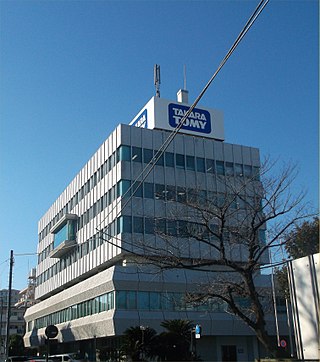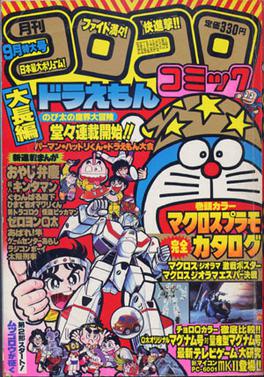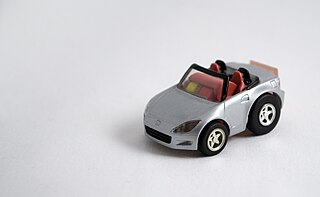
Bomberman is a video game franchise created by Shinichi Nakamoto and Shigeki Fujiwara, originally developed by Hudson Soft and currently owned by Konami. The original game, also known as Bakudan Otoko (爆弾男), was released in Japan in July 1983 and has since spawned multiple sequels and spin-offs released on numerous platforms, as well as several anime and manga adaptations.

Takara Co., Ltd. was a Japanese toy company founded in 1955. In March 2006, the company merged with Tomy Company, Ltd. to form Takara Tomy. The Takara motto was「遊びは文化」("playing is culture").

Microman was a science fiction toyline created, manufactured and marketed by Takara Co., Ltd. from 1974 to 1984 as well as from 1998 to 2007. The Microman line was a series of 3.75-inch-tall (9.5 cm) action figures with accompanying vehicles, robots, playsets and accessories. Unlike other toylines at the time, Microman figures were marketed as being the "actual" size of cyborg beings called "Micros" that hailed from a fictional planet known as "Micro Earth" and disguised themselves as action figures while on planet Earth.
Jetfire is the name of several fictional characters from the Transformers franchise. He is almost always depicted as an Autobot with flight capabilities and a jet or space shuttle as an alternate mode. In some continuities, he is a former Decepticon.

Tomy Company, Ltd. is a Japanese toy company. It was established in 1924 by Eiichirō Tomiyama as Tomiyama Toy Manufacturing Company (富山玩具製作所), became known for creating popular toys like the B-29 friction toy and luck-based game Pop-up Pirate. In 2006, Tomy merged with another toy manufacturer, Takara, and although the English company name remained the same, it became Takara Tomy in Asia. It has its headquarters in Katsushika, Tokyo.

Bomberman Jetters is an action game for the Game Boy Advance, GameCube and PlayStation 2, and part of Hudson Soft's Bomberman series. The game builds on the gameplay style established in the previous Bomberman series entry, 2002's Bomberman Generation, and features characters and settings from the 2002 anime series Bomberman Jetters. The GameCube version utilizes cel-shaded graphics similar to those of Bomberman Generation, while the PlayStation 2 version does not.

DreamMix TV World Fighters is a crossover fighting video game developed by Bitstep and published by Hudson for the GameCube and PlayStation 2 in Japan on December 18, 2003. The game features characters from Hudson and Konami's video game series and Takara's toy lines.
Sonokong Co, Ltd. (Korean: 손오공주식회사) is a Korean toy/game entertainment company. It was established in 1974. The corporate headquarters are located in Sugung-dong Guro-gu Seoul, Korea. The technical license of the company is owned by Takara and Hasbro.

CoroCoro Comic is a Japanese monthly manga magazine published by Shogakukan; established on May 15, 1977. Its main target is elementary school-aged boys. Several of its properties, like Doraemon and the Pokémon series of games, have gone on to be cultural phenomena in Japan.

Choro-Q is a line of Japanese 3–4 cm pullback car toys produced by Takara Tomy. Known in North America as Penny Racers, they were introduced in late 1978 and have seen multiple revisions and successors since. The name comes from the Japanese term choro-choro, meaning "dash around", as well as an abbreviation of the Japanese borrowing from "cute" (kyūto) to connote their petite size.

The Transformers is an animated television series that originally aired from September 17, 1984, to November 11, 1987, in syndication based upon Hasbro and Takara's Transformers toy line. The first television series in the Transformers franchise, it depicts a war among giant robots that can transform into vehicles and other objects. The series was produced by Marvel Productions and Sunbow Productions in association with Japanese studio Toei Animation for first-run syndication. Toei co-produced the show as the main animation studio for its first two seasons, having been tasked with creating and finalizing animation models, designing transformation schemes, storyboarding some episodes, and general direction. In the third season, Toei's involvement with the production team was reduced and the animation services were shared with the South Korean studio AKOM. The show's supervising producer was also AKOM's founder. The fourth season was entirely animated by AKOM. The series was supplemented by a feature film, The Transformers: The Movie (1986), taking place between the second and third seasons. This series is also popularly known as "Generation One", a term originally coined by fans in response to the re-branding of the franchise as Transformers: Generation 2 in 1992, which eventually made its way into official use. The series was later shown in reruns on Sci-Fi Channel and The Hub / Discovery Family.

Brave Exkaiser is a Japanese animated television series produced by Sunrise. The series is directed by Katsuyoshi Yatabe and written by Yasushi Hirano with both character and mecha designs done by Masayuki Hiraoka and Kunio Okawara respectively. It aired on Nagoya TV from February 3, 1990 to January 26, 1991, consisting of 48 episodes.
Transformers: Generation 1 is a toy line from 1984 to 1990, produced by Hasbro and Takara Tomy. It was a line of toy robots that could change into an alternate form by moving parts into other places, and it was the first line of toys produced for the successful Transformers toy and entertainment franchise. The line was originally called The Transformers, with "Generation 1" originating as a term coined by fans of the toys when the Transformers: Generation 2 toy line was released in 1992. Hasbro eventually adopted the term "Generation 1" to refer to any toy produced in that era.

Beyblade is a line of spinning-top toys originally developed by Takara, first released in Japan in July 1999, along with a related manga series. Following Takara's merger with Tomy in 2006, Beyblades are now developed by Takara Tomy. Various toy companies around the world have licensed Beyblade toys for their own regions, such as Hasbro in most Western countries, Sonokong in South Korea, and Takara Tomy for most Eastern countries.
Bomberman B-Daman Bakugaiden, commonly abbreviated as BB-Daman Bakugaiden (Bビーダマン爆外伝) or BBB, is a CoroCoro Comic series created by Koichi Mikata, based on Bomberman and B-Daman. An animated television series was created and originally broadcast on Nagoya TV and TV Asahi at 17:00. It was also broadcast internationally on Taiwan Television (Taiwan), TVB Jade and Spacetoon

Battle B-Daman is a Japanese manga series by Eiji Inuki which ran in CoroCoro Comics by Shogakukan from 2002 to 2005. An anime adaptation was released in January 2004. It premiered in the United States in April 2005. It is the first show of the B-Daman series to be dubbed in English. In Japan, the second season, titled Battle B-Daman: Fire Spirits!, was superseded by Crash B-Daman, a new series with an all new cast and story. The toyline was originally manufactured by Takara and was licensed by Hasbro for release in United States.
B-Daman Crossfire, known in Japan as Cross Fight B-Daman, is the first B-Daman anime of the Cross Fight series and the seventh B-Daman anime series, overall. Premiering on October 2, 2011 in Japan, it became the first B-Daman anime to air in almost five years, and first to be produced in 16:9 widescreen, following the finale of Crash B-Daman on December 25, 2006. Its last episode, Conclusion! Cross Fight's New Era aired on September 30, 2012 in Japan. A sequel series, B-Daman Fireblast, premiered the following week.

Burst Ball Barrage!! Super B-Daman is a Japanese manga series serialized in Coro Coro Comics, based on Takara's B-Daman toy. It was first released in 1995. An anime series produced by Xebec was shown in TV Tokyo between January 4, 1999 to October 1, 1999.













